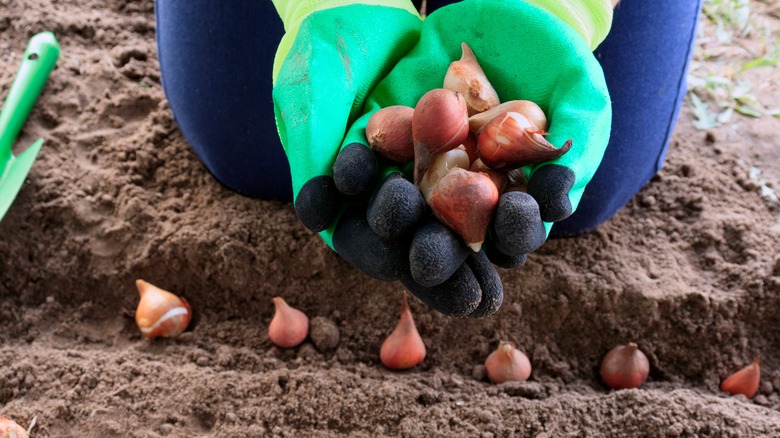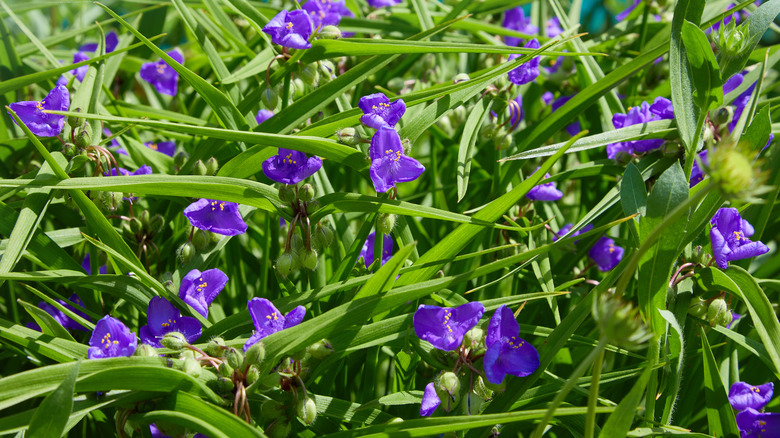Add This Easy-To-Grow Garden Flower To Attract Pollinators To Your Garden
If you love the idea of having a pollinator garden and would like to have more birds stop by your property, then you should consider growing spiderwort (Tradescantia virginiana) in your yard. Despite having an arguably unfortunate name, it's a plant that produces gorgeous green leaves and pretty purple flowers that you'll surely love to have around your home. It's these relatively small blooms that will attract lovely little creatures to your outdoor space.
Doing best in USDA zones 4b to 12a and able to grow in a range of temperatures as well as humidity levels, spiderwort appreciates getting a fair share of sun and well-drained soil that's kept relatively moist. If given a nice spot to thrive in your garden, it can grow to reach three feet tall. At the same time, spiderwort likes to spread out if given the space to do so, which means that each plant can grow to be a foot and a half wide.
On top of that, there are actually around 75 different kinds of spiderwort — including Tradescantia Amethyst Kiss, Tradescantia Concord Grape, Tradescantia Red Grape, Tradescantia Sweet Kate, and Tradescantia Purple Profusion — each offering various specifics such as exact colors. Beyond that, they're all relatively easy to grow, bloom for a decent duration from early in the springtime until late in the summer months, and attract the kind of critters to your yard that you're surely hoping to see.
Spiderwort will attract a range of creatures to your yard
When you plant spiderwort in your yard, you may find that you love to spend time gazing at it thanks to the fact that the little purple and blue-ish flowers are such a lovely addition to the exterior of your home. Of course, you won't be the only one who's captivated by this particularly pretty plant. For instance, butterflies are definitely attracted to this specific flower and like to make a meal of the nectar found in them. That's not to mention the various kinds of bees that will visit your property when you've planted spiderwort. Bees tend to appreciate the colors that spiderwort boasts, and honestly, who can blame them?
That's why it's able to attract honeybees and carpenter bees as well as halictine bees. That's not to mention the plant's biggest admirer and most prominent pollinator, which happens to be the bumblebee. On top of that, spiderwort is a favorite of syrphid flies. Although they may not be as well known as, say, a bumblebee, syrphid flies also enjoy feasting on the pollen found in the plant.
Spiderwort can harm your yard, you, and your pets
One of the reasons you might like to have spiderwort around — other than the fact that it attracts lovely creatures to your yard — is that it's so easy to grow. Of course, this also means that it can get out of hand if you don't keep it in check. In fact, spiderwort can take over your yard if you don't trim it back after it flowers. If you don't, then it will seed and more will continue to pop up around your property.
This isn't ideal, because while spiderwort is fine when restrained, it's also not good for you or any furry friends who live with you. That's due to the fact that it can cause contact dermatitis, which happens when you come into contact with something problematic and results in an itchy, uncomfortable rash, per the Mayo Clinic. It's thought to be toxic to humans, according to the Lady Bird Johnson Wildflower Center, while the American Society for the Prevention of Cruelty to Animals notes that spiderwort — which is also called an inchplant, dayflower, or purple heart — can also be poisonous to your pets. Because of this, make sure to only grow it in areas where you and any potential pets won't accidentally touch it, but where pollinators can still enjoy it.


